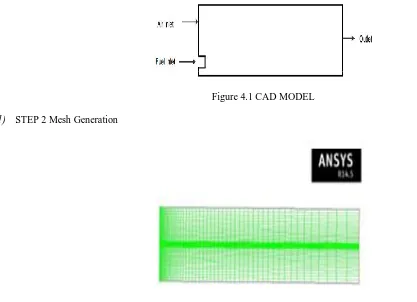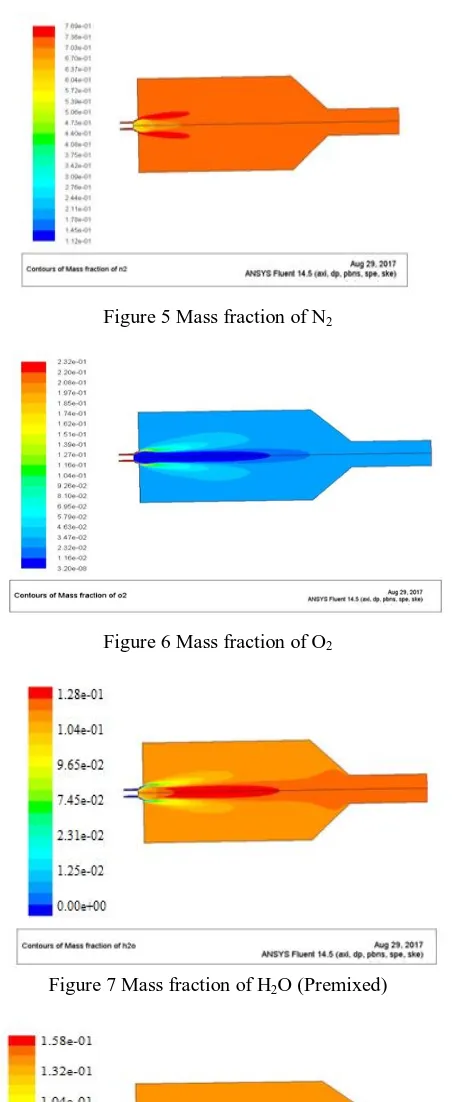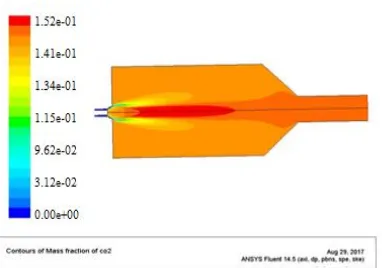Numerical Simulation and Analysis of Dual Fuel
(Diesel + Ethanol) Combustion Engine and
Comparison between Non-Premixed and Premixed
Combustion
Vishal Batti1, Vardan Singh Nayak2
1
M.Tech Scholar Mechanical Egg. Dept. VIST BHOPAL 2
Asst. Professor Mechanical Engg. Dept. VIST BHOPAL
Abstract: Alternative fuels have been getting more attention as concerns escalate over exhaust pollutant emissions produced by internal combustion engines, higher fuel costs, and the depletion of crude oil. Various solutions have been proposed, including utilizing alternative fuels as a dedicated fuel in spark ignited engines, diesel pilot ignition engines, gas turbines, and dual fuel and bi-fuel engines. Among these applications, one of the most promising options is the diesel derivative dual fuel engine with Alternate fuel as the supplement fuel. In present study we are using Ethanol as alternate fuel with Diesel to investigate the Dual fuel model with non-premixed & premixed combustion and compare on the basic of combustion efficiency and pollutant emissions rate like carbonic oxides and nitric oxides. Ethanol is taking as an Alternate fuel which is cheaper in cost and easily available as compare to the conventional fuels. CFD Results shows a excellent flow phenomenon which is stable in nature and due to this the accuracy of the simulation results are higher for layer formation system in combustion. The pollutant emissions (Carbonic oxides) are decreasing in non premixed combustion as compare to the premixed combustion that shows the complete combustion rate is increased. NOx emissions are also decreasing in Non-premixed dual fuel (Diesel + Ethanol) model as compare to premixed combustion. In second part of the study we are using Chemkin (Chemical kinetic) mechanism for evaluating the NOx pollutant which is responsible for thermal NOx . CFD Simulation results in Table no. 2 are clearly shows that mass fraction of NO, NO2 and N2O is
decreasing in Non premixed type of combustion. In current work we are taking Ethanol as a Alternate fuel which is cheaper in cost and easily available as compare to the conventional fuels.
Key words: Dual fuel, Alternate Fuel, Ethanol, Non-premixed, combustion, premixed Combustion Ansys (Fluent), CFD, Chemkin mechanism, NOx etc.
I. INTRODUCTION
behaviour and similar functional properties with diesel fuel. In both developing and developed countries biofuel are at the top of their agendas and thus it is predicted that world bio fuel production will be quadruple by 2020.
II. LITERATURE
M. Mofijur1 Ever increasing drift of energy consumption due to growth of population, transportation and luxurious lifestyle has motivated researchers to carry out research on biofuel as a sustainable alternative fuel for diesel engine. Biofuel such as biodiesel and ethanol, produced from renewable feedstock’s, are the most appropriate alternative of petroleum fuels. However, direct using of ethanol in diesel fuel face some technical problem especially in cold weather, due to low cetane number, lower flash point and poor solubility. Biodiesel can be blended with both ethanol and diesel fuel and biodiesel–alcohol–diesel blends can be used in diesel engines. The aim of this review paper is to discuss the effect of mixed blends of biodiesel alcohol and diesel on engine performance and emission parameters of a diesel engine. Most of the researchers reported that adding ethanol into biodiesel-diesel blend in diesel engines significantly reduce HC, PM, NOx and smoke emissions but slightly increase fuel consumption. The study concluded that biodiesel-diesel-ethanol blend can be used as a substitute of petro-diesel fuel to reduce dependency on fossil fuel as well as the exhaust emissions of the engine. Aman Hira2This paper is based on experimental investigation of performance and emissions of CI engine. Due to exponential growth in industrialization the demand for conventional automotive fuels is also increased sharply which adversely affects not only the economy but also the environment. This makes the search for an alternative fuel more important today. In this research the blends of ethanol & biodiesel with diesel in varying proportions are used. The performance& emission levels has been investigated under the various parameters like Brake Thermal efficiency, BSFC, BSEC, Smoke density, HC, CO & exhaust temperature. The experimental results show that the BE20 fuel gives the best performance in comparison to conventional diesel fuel along with fairly reduced exhaust emission. M.Srinivasnaik3The fuel which is used in Internal Combustion engines meant for transportation applications will satisfy all the requirements of cost effectiveness, maximum thermal efficiency, excellent engine performance, and still remain clean enough to protect the environment. Alcohol fuels such as methanol (CH3OH), Ethanol (C2H5OH) are favorable for IC Engines because of their high octane rating, burning velocities, and wider flammability limits. Alcohols can be considered as attractive alternative fuels because they can be obtained from both natural and manufactured sources. The air quality deterioration is a vital issue that needs to be seriously monitored and limited. The transportation system is a major air pollution contributor due to the exhaust emissions such as carbon monoxide (CO), hydrocarbons (HC), nitrogen oxide (NOx), carbon dioxide (CO2), and particulate matter (PM). Extensive research and development is difficult to justify until the fuels are accepted as viable for large numbers of engines. Liquid fuels are preferred for Internal Combustion Engines because they are easy to store and have reasonably good calorific value. The main alternative is the alcohol. Methanol and ethanol are two kinds of alcohols that seem most promising fuels and will likely play an increasingly important role in the future. In this review, the physical and the combustion characteristics of alcohols have been discussed briefly after comparing with the diesel. The production methods of alcohols have been discussed. The safety aspects of alcohols have also been discussed. Scott L. Springer4Due to global climate change fears, increasing levels of carbon dioxide in the atmosphere, and economic considerations, there is an interest in developing biological renewable alternatives for fossil fuels. Of particular interest in the United States, due to domestic production limits, is the development of technologies that can displace fossil fuels for internal combustion engine applications. Some popular proposed alternatives include ethanol and gasoline blended fuels, plant based oils blended with or substituted for diesel fuel, waste vegetable oil in diesel engines, and synthetic gas or “syngas” for internal combustion engines. Some promising research studying these options has been initiated in the University of Wisconsin Stout Integrated Technology Laboratory.
III. OBJECTIVE OF THE STUDY
V. METHODOLOGY A. Basic Steps to Perform CFD Analysis
1) Pre-processing: CAD Modeling: Creation of CAD Model by using CAD modelling tools for creating the geometry of the part/assembly of which you want to perform FEA.CAD model may be 2D or 3d.
2) Meshing: Meshing is a critical operation in CFD. In this operation, the CAD geometry is discredited into large numbers of small Element and nodes. The arrangement of nodes and element in space in a proper manner is called mesh. The analysis accuracy and duration depends on the mesh size and orientations. With the increase in mesh size (increasing no. of element), the CFD analysis speed decrease but the accuracy increases.
3) Type of Solver: Choose the solver for the problem from Pressure Based and density based solver.
4) Physical model: Choose the required physical model for the problem i.e. laminar, turbulent, energy, multi-phase, etc. Material Property: Choose the Material property of flowing fluid.
5) Boundary Condition: Define the desired boundary condition for the problem i.e. temperature, velocity, mass flow rate, heat flux etc.
B. Solution
1) Solution Method : Choose the Solution method to solve the problem i.e. First order, second order 2) Solution Initialization: Initialized the solution to get the initial solution for the problem.
3) Run Solution: Run the solution by giving no of iteration for solution to converge.
4) Post Processing: For viewing and interpretation of Result. The result can be viewed in various formats: graph, value, animation etc.
C. Step i geometry or model formation
[image:4.612.43.460.404.706.2]The study focuses on the to calculate the NOx percentage and the geometry used for the simulations is therefore only a part of the whole exhaust gas system in order to save computational time. The generation of the model by using ANSYS shown below:-
Figure 4.1 CAD MODEL
1) STEP 2 Mesh Generation
2) Step 3 Checks The Mesh
Various checks on the mesh and reports the progress in the console. Also check the minimum volume reported and make sure this is a positive number select mesh to mm.
D. Methods
1) Pressure based
2) 2D Model is used.
3) Gravity is enabling
4) Select Axisymmetric in the 2D Space list.
E. Model
1) Energy equation is enabled.
2) K-Epsilon turbulence model used.
3) Non-Premixed condition is used.
4) Finite rate / eddy dissipation in turbulence chemistry. Interactions are used for species model.
F. Step 4 simulation set up 1) Boundary conditions
a) Mass Flow Air inlet: - Mass flow rate is 4.0 kg/s, stability form b) Mass flow Fuel inlet – 1.0 kg/ s of Mixture
c) Outlet – pressure based.
G. Material Diesel+ ETHANOL 1) Fluid:- C2H5OH
2) Mixture: Species I H20, II-O2, III-Fuel -EG, IV-CO2, V-N2
3) Mixing law is used.
4) Thermal conductivity: - Define two polynomial coefficients
a) 0.0454 (b) 4.67*10-6
5) Polynomial coefficient for viscosity
a) 1.72e-05 (b) 3.453e-9Mass diffusivity- 2.88e-05 m2/s 6)For absorption coefficient take stable domain. 7)Scattering coefficient is 1.02e-7.
8) Step 5 Solutions
H. Method
1) Coupled
2) Presto model is used:-
3) Note: -Higher time scale size is used for the energy and species equation to converge the solution in less number of iterations. 4) Solution Initialisation: The solution is initialized
VI. RESULTS AND CONCLUSION A. Results
Figure 1 Total temperature contour in premixed type combustion
[image:6.612.219.419.248.349.2]Figure 2 Total Temperature contour in Non-premixed type combustion
Figure 3 Velocity contour in premixed type combustion
Figure 5 Mass fraction of N2
[image:7.612.196.431.587.708.2]Figure 6 Mass fraction of O2
Figure 7 Mass fraction of H2O (Premixed)
Figure 9 Mass fraction of CO2 (Premixed)
Figure 10 Mass fraction of CO2 (Non-Premixed)
Results Table No.1
[image:8.612.181.433.407.684.2]NOx( Premixed and Non-premixed)
Figure 12 Mass fraction of NO2 (Non-premixed)
Figure 13 Mass fraction of NO (Pre-mixed)
[image:9.612.206.434.515.700.2]Figure 15 Mass fraction of N2O (Pre-mixed)
Figure 16 Mass fraction of N2O (Non-Premixed)
VI. CONCLUSION
In present study we investigate the Dual fuel system (Diesel + Ethanol) with Non-premixed and premixed model and compare the results basic of Temperature, Flame phenomenon, Stability and Pollutant emissions like carbonic oxides and Nitric oxides. Simulation results shows in table no. 1 that temperature is increased in non premixed type of mixing and rapid mixing is occurred because velocity magnitude is also increased due to this combustion efficiency is increased. The pollutant emissions (Carbonic oxides) are decreasing in non premixed combustion as compare to the premixed combustion that shows the complete combustion rate is increased. In second part of the study we are using Checking (Chemical kinetic) mechanism for evaluating the NOx pollutant which is responsible for thermal NOx. CFD Simulation results in Table no. 2 are clearly shows that mass fraction of NO, NO2 and N2O is decreasing in Non premixed type of combustion. In current work we are taking Ethanol as a Alternate fuel which is cheaper in cost and easily available as compare to the conventional fuels.
REFERENCES
[1] M. MofijurRecent Developments on Internal Combustion Engine Performance andEmissions Fuelled With Biodiesel-Diesel-Ethanol BlendsProcedia Engineering 105 ( 2015 ) 658 – 664.
[2] Aman Hira PERFORMANCE & EMISSION CHARACTERISTICS OF CI ENGINE USING BLENDS OF ETHANOL AND BIODIESEL WITH DIESEL
International Journal of Engineering Research & Technology (IJERT) Vol. 1 Issue 5, July - 2012 ISSN: 2278-0181
[3] M.Srinivasnaik Alcohols as Alternative Fuels for Diesel Engines:A REVIEWI international Journal for Research in Applied Science & EngineeringTechnology (IJRASET) Volume 3 Issue VI, June 2015 IC Value: 13.98 ISSN: 2321-9653
[4] Scott L. Springer Experimental Evaluation of Alternative Fuels for Internal Combustion Engines Session ETD 445 Proceedings of the 2013 Conference for Industry and Education Collaboration
[5] Kamaltdinov V.G. Modeling the combustion process of a powerful diesel engine Procedia Engineering 129 ( 2015 ) 488 – 494
[6] Murugan Sivalingam Validation of some engine combustion and emission parameters of a bio ethanol fuelled DI diesel engine using theoretical modelling Alexandria Engineering Journal (2015) 54, 993–1002
[7] Haozhong Huang The potentials for improving combustion performance and emissions in diesel engines by fueling nbutanol/diesel/PODE3-4 blends Energy Procedia 105 ( 2017 ) 914 – 920ScienceDirectThe 8th International Conference on Applied Energy – ICAE2016
[8] MidhatTalibi Combustion and exhaust emission characteristics, and in-cylinder gas composition, of hydrogen enriched biogas mixtures in a diesel engine Energy 124 (2017) 397e412.
[9] HimsarAmbaritaPerformance and emission characteristics of a small diesel enginerun in dual-fuel (diesel-biogas) modeCase Studies in Thermal Engineering 10 (2017) 179–191
[10] FtwiYohanessHagosEffect of Air-fuel Ratio on the Combustion Characteristics of Syngas(H2:CO) in Direct-injection Spark-ignition EngineEnergy Procedia 61 ( 2014 ) 2567 – 2571Peer-review under responsibility of the Organizing Committee of ICAE2014doi: 10.1016/j.egypro.2014.12.047The 6th International Conference on Applied Energy – ICAE2014
[11] Daniel CarderEmissions Control Challenges for Compression Ignition EnginesProcedia IUTAM 20 ( 2017 ) 103 – 1114th International Congress of Theoretical and Applied Mechanics
[12] YanuandriPutrasariThe 8th International Conference on Applied Energy – ICAE2016Energy Procedia 105 ( 2017 ) 1743 – 1750 [13] SakdaThongchaiInfluence of Injection Strategy on a Compression Ignition
[14] Engine Fueled with GasolineEnergy Procedia 105 ( 2017 ) 1757 – 1763The 8th International Conference on Applied Energy – ICAE2016 [15] Vu Dinh NamStudy on Auto-Ignition Characteristics of Gasoline-Biodiesel
[16] Blend Fuel in a Rapid Compression Expansion MachineEngineering Science and Technology, an International Journal 19 (2016) 438–443 [17] P. BaskarEffects of oxygen enriched combustion on pollution and performance





